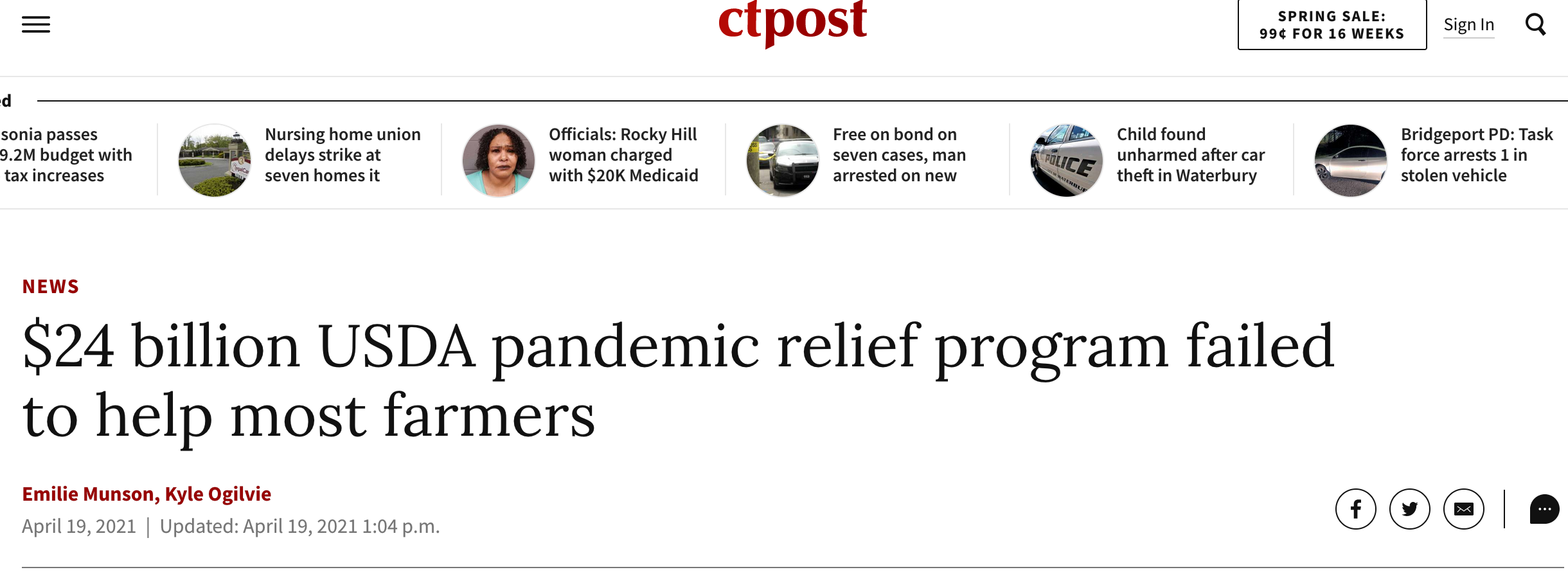
Uncovering Inequity in USDA’s Coronavirus Food Assistance Program
Of the $20 billion in CFAP aid distributed, only 43% of farmers nationwide benefited.
In Nebraska, 99.7% received CFAP aid.
In New York, only 23% of farmers benefitted.
In Connecticut, that number is 8%.
In September of 2020, I joined DataKind DC’s partnership with the National Press Foundation (NPF) to help reporters investigate government pandemic programs. We analyzed scads of data and uncovered evidence that directly fueled articles which ran in state newspapers in Florida, Illinois, New York & Connecticut (in addition to a few articles in national papers).
Emilie Munson of Hearst Newspapers, one of the NPF fellows, was focused specifically on the various governmental aid programs targeted towards New England . I teamed up with her and we began digging into the coronavirus relief programs targeted towards agriculture that were flowing into the region.
We focused our investigation on three datasets — the Paycheck Protection Plan (PPP) data released by the Small Business Administration (SBA), the Coronavirus Food Assistance Program (CFAP) data Emilie FOIA’d from the USDA, and the Market Facilitation Program (MFP) from the USDA.
After swimming through these data for some time, our analysis — which deduplicated CFAP data to get a solid read on how many unique farms got a grant — showed that there was a noticeable disparity in how these grants were dispersed. The disparity between states was so meaningful that Representative Paul Tonko and Senator Kirsten Gillibrand spoke to Emilie on the record for the Albany Times-Union article. Connecticut’s Agriculture Commissioner commented for the Connecticut Post article, supporting a conclusion easily drawn from the state-by-state comparison: CFAP favored bigger farms with an existing pulse on the USDA’s grant activities and left smaller farms to proactively opt-in to the program, if they even heard about it.
These articles helped put a solid data foundation to the very human plight of farmers during the pandemic. Tom Vilsack, the Secretary of Agriculture recently promised that“[t]he Biden-Harris Administration is committed to helping as many producers as possible, as equitably as possible”.
In May of 2021, Senate Majority Leader Chuck Schumer sent a letter to the Secretary of Agriculture directly citing our work on CFAP equity.
In a letter reported on by the Times Union, Schumer notes that “[m]any specialty crops, important to New York’s agricultural industry and heritage, were excluded from eligibility when the Coronavirus Food Assistance Program (CFAP) was first introduced.” He urged Secretary Vilsack to improve data collection on specialty crops, increase outreach to smaller farm operations, and intentionally include dairy and specialty crops in a recompense initiative and future initiatives.
Explore the full articles below (Connecticut Post has a paywall —support local journalism!)
An explainer for how we reported this story was also published in the Albany Times-Union.
The Times Union article reporting on Senator Schumer’s letter to Secretary Vilsack is available below.



